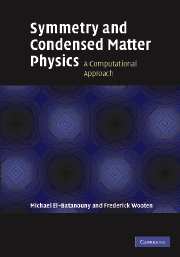Book contents
- Frontmatter
- Contents
- Preface
- 1 Symmetry and physics
- 2 Symmetry and group theory
- 3 Group representations: concepts
- 4 Group representations: formalism and methodology
- 5 Dixon's method for computing group characters
- 6 Group action and symmetry projection operators
- 7 Construction of the irreducible representations
- 8 Product groups and product representations
- 9 Induced representations
- 10 Crystallographic symmetry and space-groups
- 11 Space-groups: Irreps
- 12 Time-reversal symmetry: color groups and the Onsager relations
- 13 Tensors and tensor fields
- 14 Electronic properties of solids
- 15 Dynamical properties of molecules, solids, and surfaces
- 16 Experimental measurements and selection rules
- 17 Landau's theory of phase transitions
- 18 Incommensurate systems and quasi-crystals
- Bibliography
- References
- Index
2 - Symmetry and group theory
Published online by Cambridge University Press: 06 July 2010
- Frontmatter
- Contents
- Preface
- 1 Symmetry and physics
- 2 Symmetry and group theory
- 3 Group representations: concepts
- 4 Group representations: formalism and methodology
- 5 Dixon's method for computing group characters
- 6 Group action and symmetry projection operators
- 7 Construction of the irreducible representations
- 8 Product groups and product representations
- 9 Induced representations
- 10 Crystallographic symmetry and space-groups
- 11 Space-groups: Irreps
- 12 Time-reversal symmetry: color groups and the Onsager relations
- 13 Tensors and tensor fields
- 14 Electronic properties of solids
- 15 Dynamical properties of molecules, solids, and surfaces
- 16 Experimental measurements and selection rules
- 17 Landau's theory of phase transitions
- 18 Incommensurate systems and quasi-crystals
- Bibliography
- References
- Index
Summary
Groups and their realizations
Abstract group theory defines relationships among a set of abstract elements in terms of binary operations among the elements of the group. The operations are known as group multiplication.
Formally, a group consists of a set of elements with the following properties:
(i) The product of any two elements in the set is a member of the set. Thus the set is closed under all group multiplication operations.
(ii) If A, B, and C are elements of the group, then A(BC) = (AB)C. The associative law of multiplication holds; the commutative law of multiplication need not hold.
(iii) There is a unit element, an identity element, E such that EA = AE = A.
(iv) Each element A has a unique inverse A−1 such that AA−1 = A−1A = E.
A typical abstract group multiplication table is given in Table 2.1, for the group we denote by G6, which consists of six elements.
The convention for such tables is that the ij th element in the table is the product of the ith element labeling the rows and the j th element labeling the columns. From the table we see that AB = D, which means that the operation B followed by the operation A is equivalent to the single operation D. Note that AB = D, but BA = F; thus AB ≠ BA in this case.
Abelian groups If XY = YX for all elements of the group, the group is called Abelian. It is clear from the asymmetry about the diagonal of Table 2.1 that the group G6 is not Abelian.
- Type
- Chapter
- Information
- Symmetry and Condensed Matter PhysicsA Computational Approach, pp. 21 - 50Publisher: Cambridge University PressPrint publication year: 2008



